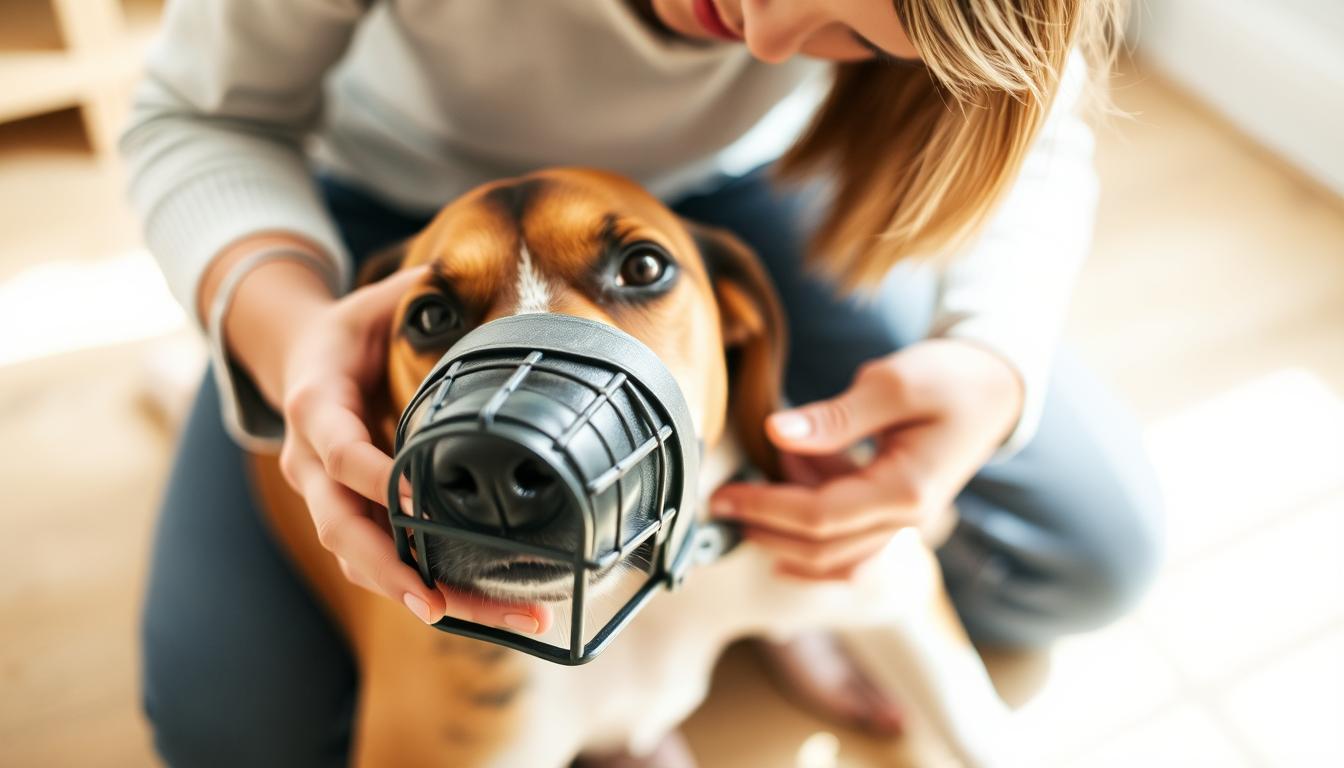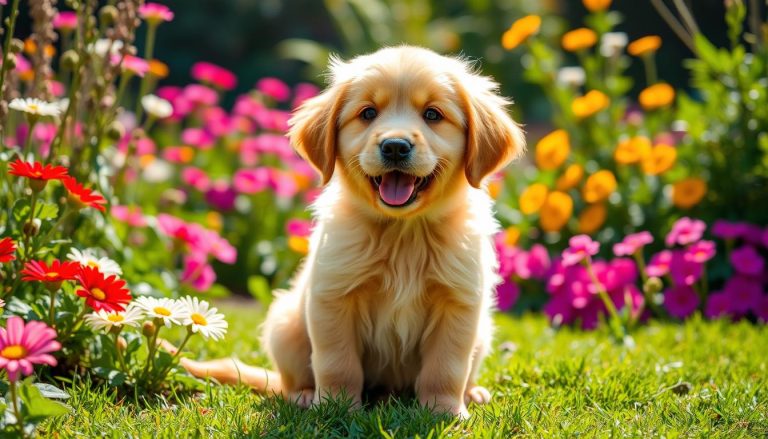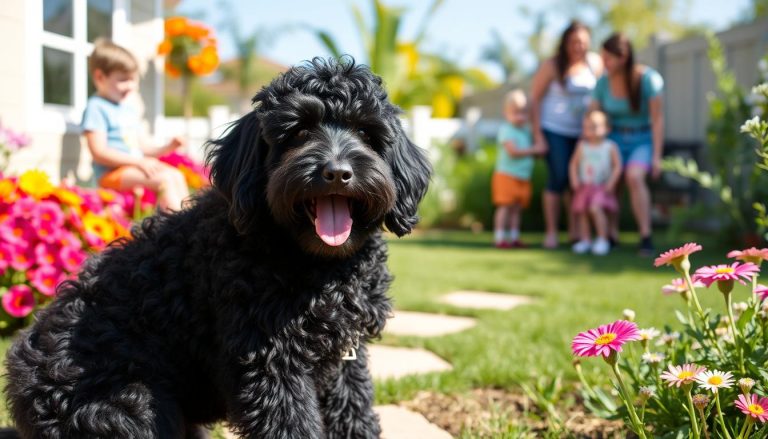Train Your Dog to LOVE Their Muzzle (Yes, Really!) in 5 Simple Steps
Muzzle training is an essential aspect of responsible dog ownership, especially for dogs that are prone to barking, biting, or chewing. It’s a process that requires patience, consistency, and positive reinforcement.
Many dog owners view muzzles as restrictive or punitive, but with the right approach, your dog can learn to love wearing one. Our step-by-step guide will walk you through the process, making it a stress-free experience for both you and your dog.
By following these simple steps, you’ll be able to help your dog become comfortable with their muzzle, making vet visits, walks, and social interactions much easier.
Key Takeaways
- Understand the importance of muzzle training for your dog’s well-being.
- Learn a simple, step-by-step process to introduce your dog to their muzzle.
- Discover tips for making muzzle training a positive experience.
- Find out how to gradually increase your dog’s comfort level with their muzzle.
- Gain confidence in your ability to muzzle train your dog effectively.
Why Muzzle Training Is Important for Every Dog
Positive muzzle training is a game-changer for dogs that are fearful, anxious, or reactive. It’s an essential tool for dog owners who want to ensure their pets are well-behaved in public and at home.
Common Misconceptions About Muzzles
Many people believe muzzles are only for aggressive dogs, but this isn’t true. Muzzles can be beneficial for any dog, regardless of temperament, as they help prevent unwanted behaviors like barking or biting during stressful situations.
Benefits of a Properly Muzzle-Trained Dog
A properly muzzle-trained dog is not only more comfortable in public but also safer for both the dog and those around it. Muzzle training helps in reducing stress during vet visits, grooming, or when encountering other dogs. By getting your dog used to a muzzle, you’re taking a proactive step towards creating a more harmonious and safe environment.
By understanding the importance of muzzle training and implementing it correctly, dog owners can enjoy a more stress-free life with their pets. It’s about creating a positive association with the muzzle, making it a normal part of their dog’s life.
Choosing the Right Muzzle for Your Dog
The right muzzle can make all the difference in your dog’s stress-free training experience. A muzzle is not a restraint, but a tool to help your dog feel more comfortable in various situations.
Types of Muzzles and Their Uses
There are several types of muzzles available, each designed for specific purposes and dog breeds. The most common types include basket muzzles, nylon muzzles, and metal muzzles.
- Basket muzzles allow dogs to pant and drink while wearing them, making them a comfortable choice for extended wear.
- Nylon muzzles are lightweight and easy to clean, suitable for dogs that need a muzzle for short periods.
- Metal muzzles are durable and often used for dogs with powerful jaws or for specific training needs.
Finding the Perfect Fit
A well-fitting muzzle is crucial for your dog’s comfort and the effectiveness of the training. To ensure a proper fit, measure your dog’s snout circumference and length.
| Muzzle Size | Snout Circumference | Snout Length |
|---|---|---|
| Small | 10-12 inches | 3-4 inches |
| Medium | 13-15 inches | 4-5 inches |
| Large | 16-18 inches | 5-6 inches |
When introducing the muzzle, use the humane method by starting with short sessions and rewarding your dog with treats. This positive association will help your dog become comfortable wearing the muzzle.
Step 1: How to Muzzle Train a Dog – Creating Positive First Impressions
Creating a positive first impression is crucial when introducing a muzzle to your dog. The journey to a well-muzzle-trained dog begins with a crucial step: creating a positive association with the muzzle. This initial step sets the tone for the entire training process, ensuring your dog views the muzzle as a non-threatening object.
Introducing the Muzzle as a Positive Object
To start, place the muzzle near your dog’s favorite resting spot or during meal times, allowing them to become familiar with its presence. You can also place treats near the muzzle to create a positive link. It’s essential to let your dog approach and explore the muzzle at their own pace, without any pressure.
Using High-Value Treats for Association
High-value treats play a significant role in creating a positive association with the muzzle. By associating the muzzle with rewards, your dog will begin to see it as a positive object. Start by offering treats through the muzzle or near it, gradually increasing the proximity. This process helps your dog build a positive connection with the muzzle.
To further reinforce this positive association, consider the following table that outlines a simple treat-based introduction plan:
| Day | Treat Placement | Goal |
|---|---|---|
| 1-2 | Near the muzzle | Familiarize dog with muzzle presence |
| 3-4 | Through the muzzle | Associate muzzle with reward |
| 5+ | Inside the muzzle | Build confidence with muzzle on |
By following these steps and using high-value treats, you can create a positive first impression and lay the groundwork for successful muzzle training. Remember, patience and consistency are key to helping your dog feel comfortable and confident with their muzzle.
Step 2: Touch Training and Rewarding Curiosity
Once your dog is familiar with the muzzle, it’s time to introduce touch training to build a positive association. This step is crucial as it helps your dog become comfortable with the muzzle’s presence and touch.
Encouraging Nose Touches
To start touch training, hold a treat near your dog’s nose and slowly move it towards the muzzle. As their nose touches the muzzle, give them the treat and praise them. This positive reinforcement helps your dog associate the muzzle with positive experiences.
“The key to successful muzzle training is patience and consistency,” says dog training expert, Jane Smith. “By gradually introducing the muzzle and rewarding curiosity, you can help your dog feel more at ease.”
Building Duration with the Muzzle
As your dog becomes more comfortable touching the muzzle, it’s time to build duration. Start by having your dog touch the muzzle for a longer period before giving them a treat. Gradually increase the time they need to keep their nose near or on the muzzle.
To make this process more engaging, you can use a variety of treats and toys, keeping the training sessions short and fun. The goal is to create a positive association that lasts.
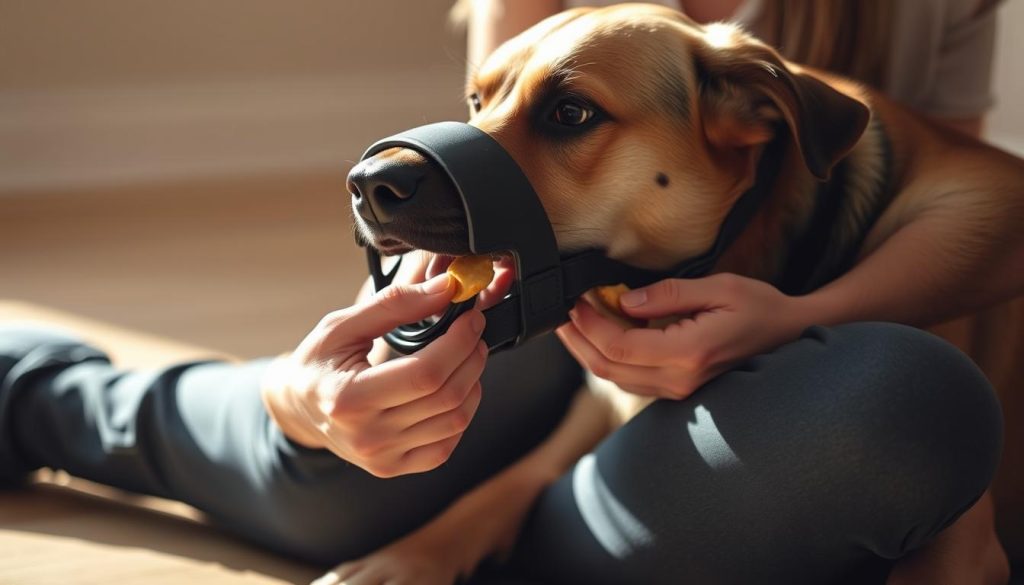
By following these steps and maintaining a patient and consistent approach, you can successfully muzzle train your dog, ensuring they remain calm and comfortable throughout the process.
Step 3: Transitioning to Wearing the Muzzle
The third step in muzzle training involves transitioning your dog to wear the muzzle, ensuring a stress-free experience. This phase is crucial as it builds on the foundation established in the previous steps, where your dog became familiar and comfortable with the muzzle’s presence.
Gradual Strapping Techniques
To begin strapping the muzzle, start by holding it in place with your hands and rewarding your dog with treats. Gradually introduce the straps, beginning with simple actions like buckling and unbuckling the muzzle while it’s not on your dog. Once they’re comfortable with this, you can proceed to strap it on loosely, ensuring it’s not too tight.
Key steps include:
- Introducing the straps gradually
- Rewarding your dog for remaining calm
- Adjusting the fit to ensure comfort
Extending Wear Time Comfortably
As your dog becomes accustomed to wearing the muzzle, it’s essential to extend the wear time gradually. Begin with short periods, such as a few seconds, and gradually increase the duration. Monitor your dog’s comfort and stress levels, adjusting the pace as needed.
| Duration | Activity | Reward |
|---|---|---|
| 0-10 seconds | Simply wearing the muzzle | Treats and praise |
| 10-30 seconds | Moving around the room | Continue with treats |
| 30+ seconds | Engaging in simple commands | Praise and occasional treats |
By following these steps and maintaining a humane, stress-free approach, your dog will learn to wear the muzzle comfortably, enhancing their training and your bond.
Step 4: Movement and Activity While Muzzled
The fourth step in muzzle training involves acclimating your dog to movement and activity while muzzled, ensuring a stress-free experience. This step is crucial in helping your dog become comfortable in their muzzle during various situations.
Indoor and Outdoor Training Sessions
Begin by having your dog wear the muzzle during indoor activities, such as walking around the house or playing with their favorite toys. Positive reinforcement is key; reward them with treats and praise for calm behavior. Gradually introduce outdoor activities, starting with short walks and gradually increasing the duration.
It’s essential to maintain a calm and assertive demeanor during these training sessions. Your dog will pick up on your energy, so ensure you’re providing a positive and reassuring presence.
Making Muzzle Time Fun Time
To make muzzle time enjoyable for your dog, incorporate activities they love, such as playing fetch or going for a hike. Make it a game by hiding treats or toys and encouraging your dog to find them while wearing their muzzle.
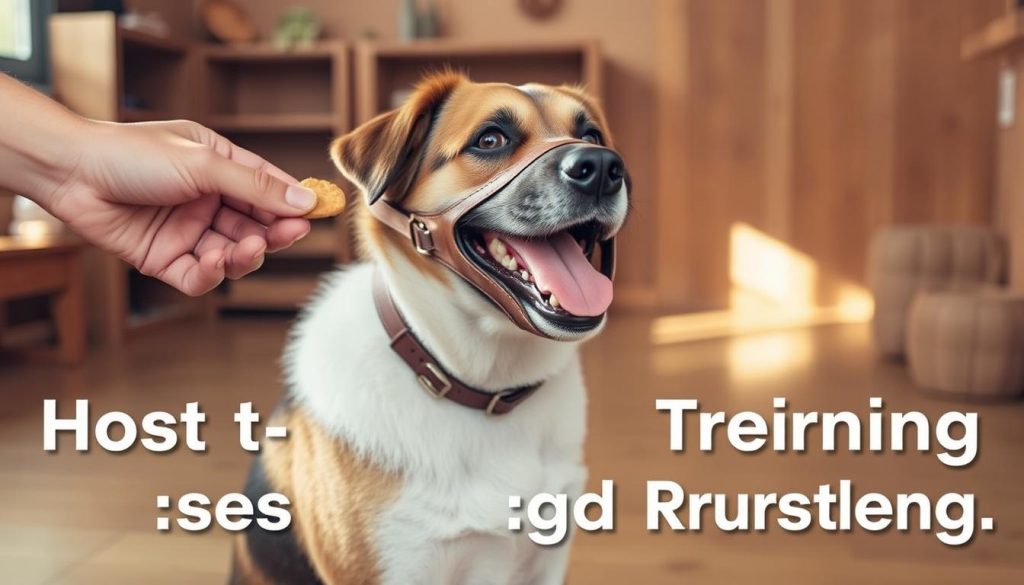
By associating the muzzle with fun activities, you’ll help your dog develop a positive association with it. Remember to reward good behavior and be patient with your dog as they learn to navigate different situations while muzzled.
Through consistent training and positive reinforcement, your dog will become comfortable wearing their muzzle during various activities, making get dog used to muzzle a breeze.
Step 5: Maintaining Positive Associations Long-Term
The final step in muzzle training involves more than just wearing the muzzle; it’s about creating a lifelong positive connection. To achieve this, you must continue practicing and reinforcing what your dog has learned.
Ongoing practice is key to maintaining a positive association with the muzzle. Regularly incorporating the muzzle into your dog’s daily activities will help keep their perception positive.
Ongoing Practice Strategies
To keep the muzzle a positive object, continue using high-value treats during training sessions. You can also make muzzle time fun by incorporating games and activities while your dog is muzzled.
Another strategy is to vary the context in which your dog wears the muzzle, such as during walks or at the vet’s office, to help them generalize their positive association.
Troubleshooting Common Challenges
If your dog starts to show signs of distress or negativity towards the muzzle, revisit earlier steps in the training process and adjust your approach as needed.
Conclusion: A Happier, Safer Future Together
Successfully training your dog to wear a muzzle can significantly enhance the quality of life for both you and your pet. By following the five simple steps outlined in this article, you can ensure a positive muzzle training experience. This process not only helps in reducing stress during vet visits or in crowded areas but also fosters a deeper bond between you and your dog through trust and understanding.
Learning how to muzzle train a dog requires patience, consistency, and positive reinforcement. As you’ve seen, it’s a straightforward process that yields long-term benefits. With positive muzzle training, you can help your dog become more confident and calm in various situations, making outings and interactions more enjoyable for everyone involved.
Embarking on this training journey is a step towards creating a happier, safer future for your dog and those around them. By investing time and effort into muzzle training, you’re not just enhancing your dog’s life but also contributing to a more harmonious community. Start your positive muzzle training journey today and discover the difference it can make.

